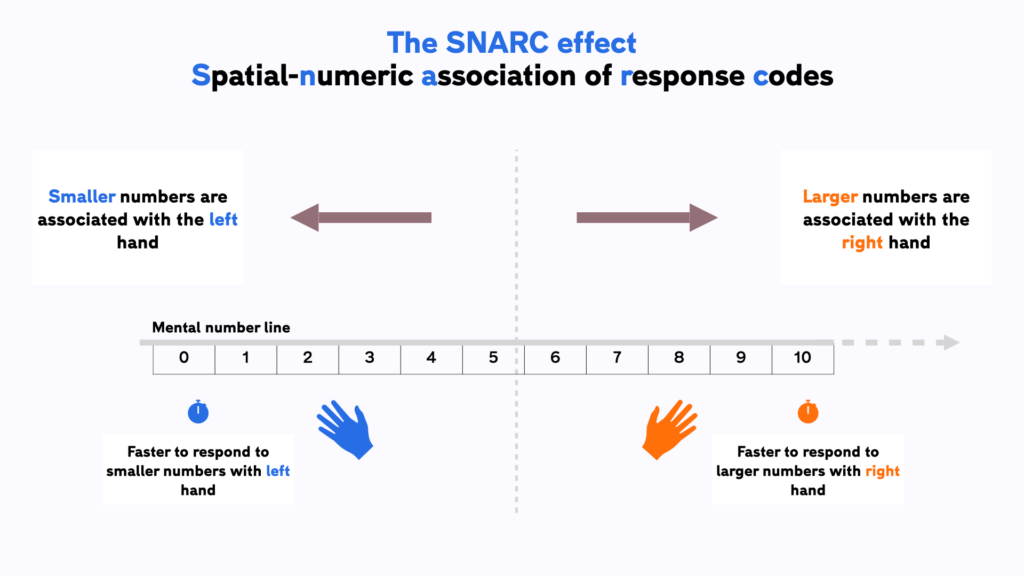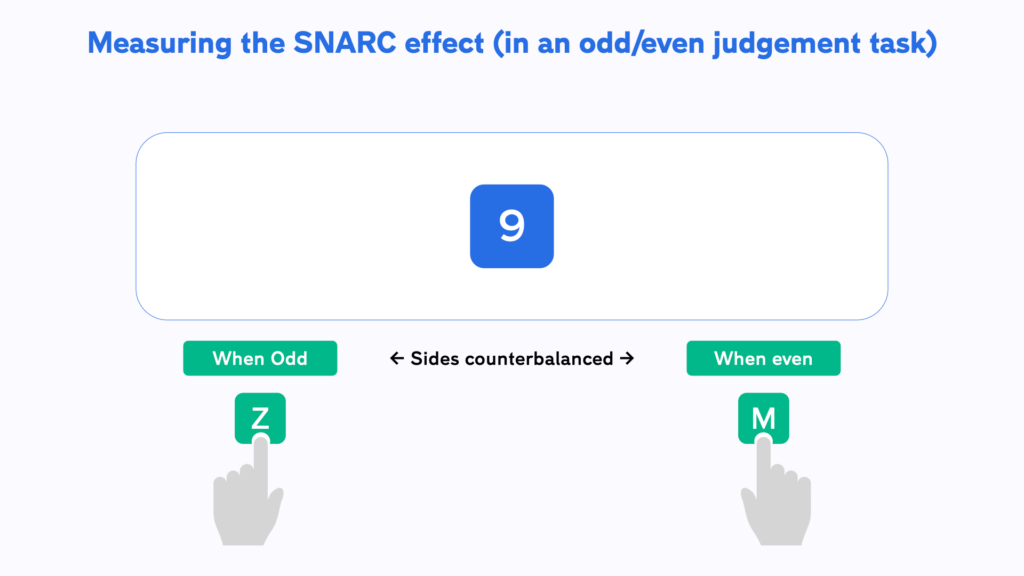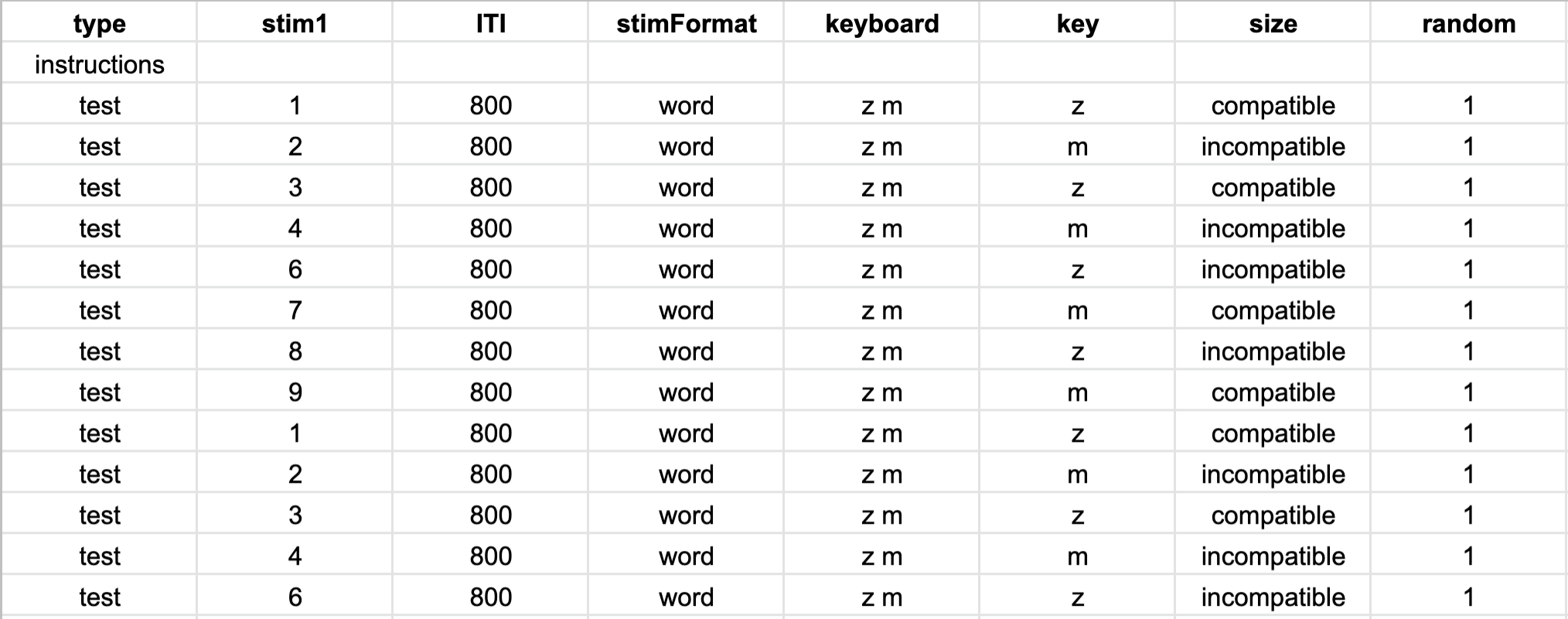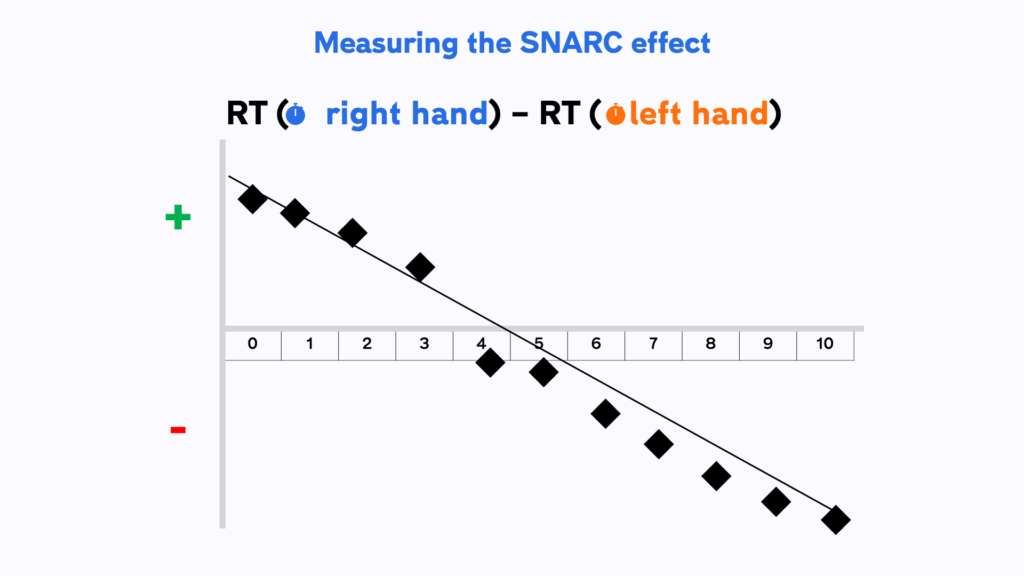If you never worked with Testable before, you can check out our 10-minute video introduction here
When we perceive space, we intuitively understand concepts like closer and further, or larger and smaller. These perceptions might underlie our understanding of numbers and give rise to our ability to develop mathematical intuitions.
One important discovery that links our spatial perception and numerical understanding is the SNARC effect (short for ‘Spatial Numeric Association of Response Codes‘). The effect emerges in tasks where participants need to respond to numbers by using their left and right hand. As it turns out, we’re slightly faster to respond to smaller numbers with our left hand and to larger numbers with our right hand.

Which exact numbers ‘belong’ to which hand depends on the general pool of numbers that are relevant in a task. If numbers are in the range of 1 to 10, 2 might be a small number and 4 a large number. If numbers are 1-100, then even 22 might be perceived as a small number, for which the left hand has a slight bias.
This effect is evidence for the existence of a mental number line that extends from left to right in our spatial perception. Unlike an actual number line, no specific numbers are represented, but instead relative magnitudes that change depending on context. We think of generally ‘small stuff’ as being on the left, while generally ‘large stuff’ on the right.
Interestingly, this effect is non-existent, or even reversed for individuals who have grown up with a writing system that is reversed, meaning right-to-left. This shows that we learn these associations over time as our brain adapts its spatial understanding to the more abstract task of numeric cognition.
You can observe the SNARC effect using a range of tasks where participants respond to numbers using both hands. Our example experiment is an odd/even judgement task. It simply requires participants to indicate whether the number shown on screen is odd or even.
Each number (between 1 and 9 and excluding 5, to avoid the middle point and enhance the effect) is presented until a response is given. In one half of the experiment participants need to press the ‘Z’ key with their left hand when numbers are odd and the ‘M’ key with their right hand when they are even. These mappings are reversed in the second half of the experiment.
In our example experiment there are a total of 64 trials, showing each number 8 times. This is usually enough to capture the SNARC effect, but more trials will result in more robust measurements. Testable will measure response times and accuracy automatically.

Run this experiment in Testable from our ready-made template
You can import this experiment for free from our Library. It is set up and ready to go and you can start collecting data straight away by sending the experiment link to your participantsafter importing it to your projects. Experiments in Testable will run in every browser. This makes it very easy to collect data both in the lab as well as online.
We can use an odd/even task to see if participants find it easier (i.e. are faster) to respond to smaller numbers with their left hand, and larger numbers with their right hand.
If response times are faster for the pairing of smaller numbers with a left-key response and vice versa, it is evidence for the automatic association of magnitudes and space: the SNARC effect.
Experiments in Testable are fully customisable and you will not need to write a single line of code to edit them. The heart of each experiment is what we call the trial file. The trial file contains all information that Testable needs to run the experiment in a simple spreadsheet, that you can edit with any spreadsheet editor you like, such as Google Sheets, Excel or Testable’s in-built preview editor.
To change any part of your experiment, you only need to change the values in the trial file.
Once you have made your changes, you can save and upload the modified trial file to your experiment’s trial file section.

Here is an example of changes you might want to make to the SNARC odd/even judgement task:
Relative magnitude, not absolute numbers matter
As noted before, the SNARC mapping of left=small and right=large does not only apply to specific numbers. What matters instead is the relative magnitude of a number within its context. You can test this hypothesis by creating a between-subjects version of this task.
To create a between-subjects experiment you need to:
Testable will now automatically show only the trials from one randomly chosen condition to any participant that begins the task. You should expect to see the SNARC effect in both groups. A large number in Group 1 (e.g. 8) that displays a right-hand bias, might actually display a left-hand bias for Group 2. This is because the mid-point of the mental number-line is shifted in the presence of larger numbers.
After importing this template to your library, you can collect data for your experiment by sharing the unique experiment link (i.e. tstbl.co/xxx-xxx) with your participants. Once participants complete the experiment, their results will appear in the ‘Results’ section of your experiment.
The results file that you get when a participant completes the SNARC effect task (odd/even judgement task) contains all information from your trial file and additional columns about the participants responses. The column from the results that will be most useful for your analysis is the RT (response time) column.
In the trial file we have also defined one custom column called size. We have used it to mark the trials either to be ‘compatible’ or ‘incompatible’. Whenever the correct odd/even judgement for a number from 1-4 (small number) falls on the ‘Z’ key, it is classified as compatible, as the left hand corresponds to smaller numbers. Larger numbers (6-9) paired with the ‘M’ key are also ‘compatible’, the opposite pairings are therefore ‘incompatible’. The size column does not affect the experiment in any way, but will help us with data analysis as we can now easily group our results.
The original SNARC effect is defined as a significant downward slope when plotting the reaction time differences of right- and left-hand responses for each of the numbers. This difference will be positive for smaller numbers as left-hand responses will be quicker and vice versa. You can see in the illustration below how to visualise the full SNARC effect for the range of numbers that are tested.

We can, however, compute a simplified effect that is more robust even with a smaller number of trials. For that we will simply have to compute the reaction time averages for all ‘compatible’ and ‘incompatible’ trials. For that you can:
The mean reaction time for incompatible trials should be larger than for compatible trials. This effect shows that in trials with left-hand responses for large numbers and right-hand responses for small numbers, participants took a little longer to process the unnatural matching.
Once you have collected data from multiple participants, you can also use Testable’s ‘wide format’ feature, that allows you to automatically collate all individual result files into a single file. In wide format results, every participant’s data is represented as one row in the data. This makes it easily compatible with statistical analysis packages like R or SPSS where you can assess the statistical significance of any differences you may find.
Reference list:
Dehaene, S., Bossini, S., & Giraux, P. (1993). The mental representation of parity and number magnitude. Journal of Experimental Psychology: General, 122(3), 371.
Wood, G., Willmes, K., Nuerk, H. C., & Fischer, M. H. (2008). On the cognitive link between space and number: A meta-analysis of the SNARC effect. Psychology Science Quarterly, 50(4), 489.